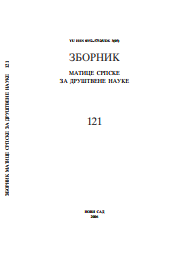ДЕМОГРАФСКА КРЕТАЊА У МАЂАРСКОЈ НА ПРЕКРЕТНИЦИ МИЛЕНИЈУМА
DEMOGRAPHIC TRENDS IN HUNGARY AT THE TWIN OF THE MILLENIUM
Author(s): Pirisi Gábor, András TrócsányiSubject(s): Demography and human biology, Transformation Period (1990 - 2010)
Published by: Матица српска
Keywords: demographic crisis; small towns (palanke); types of demographic small towns;
Summary/Abstract: Hungary belonging more and more to the pestigious group of developed countries can be characterised more and more by the demographic characteristics of those. Aging population, decreasing live birth, decreasing figure of the population are commonly used terms characterising the demographic profile of our country. This simplified picture can be modulated and coloured with the help of spatial data. In spite of the comparatively small size, and relatively homogenous structure of Hungary several differences can be found. The network of small towns could be an obvious and representative sample for the spatial investigations as the elements of that almost totally cover the area of Hungary, it is numerous enough, but still easy to handle. Within a Hungarian geographical context settlements having a maximum of 30,000 inhabitants and possessing city rank can be defined as small towns. Because of their size and functions they are sensitive enough to illustrate the national demographic tendencies, but they are numerous enough to split into different gropus according to their remarkably diverse character. Traditional historic small towns widely differ from the ones located in the rapidly urbanising agglomerations, even though the socialist new towns having similar origin reflect significant demographic variants.
Journal: Зборник Матице српске за друштвене науке
- Issue Year: 2006
- Issue No: 121
- Page Range: 465-478
- Page Count: 14
- Language: Serbian

